Menus
- Power naked bikes in a comparison test
- The challenger is called Suzuki GSX-S 1000
- No unpleasant vibrations on the KTM 1290 Super Duke R.
- ABS in the BMW S 1000 R regulates late in dynamic mode
- Simple equipment also has its advantages
- Unfortunately the Suzuki GSX-S 1000 lacks an anti-hopping clutch
- GSX-S can convince in its own way
- All three bikes are doing really well
- Technical specifications
- Readings
- rating
- rating
- Conclusion
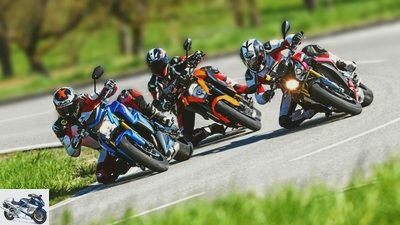
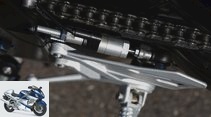
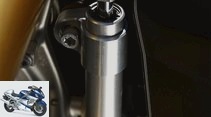
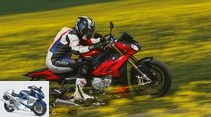
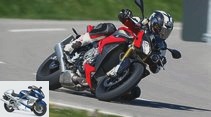
41 photos
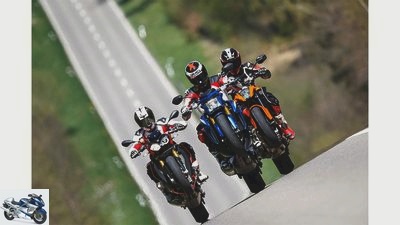
1/41
BMW S 1000 R, Suzuki GSX-S 1000 and KTM 1290 Super Duke R.
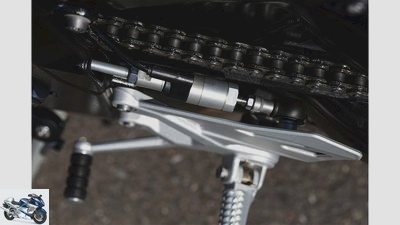
2/41
The shift assistant from BMW’s “HP Shop” is only available at an additional cost.

3/41
Despite the electronically adjustable chassis, the BMW S 1000 R cannot do without a steering damper.

4/41
BMW S 1000 R..
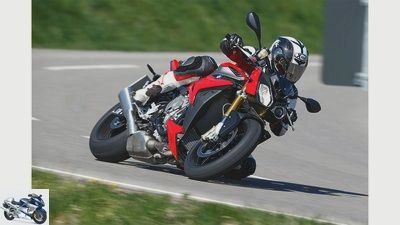
5/41
BMW S 1000 R..
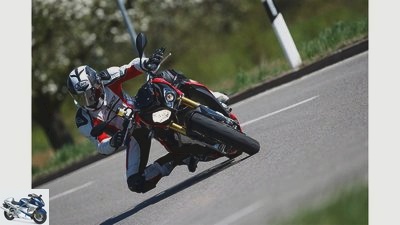
6/41
BMW S 1000 R..
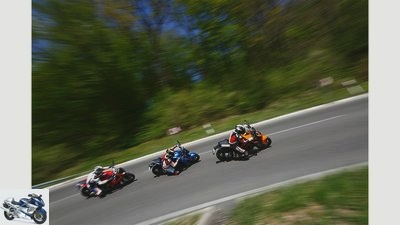
7/41
BMW S 1000 R, Suzuki GSX-S 1000 and KTM 1290 Super Duke R.
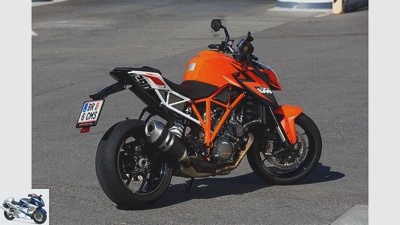
8/41
KTM 1290 Super Duke R..
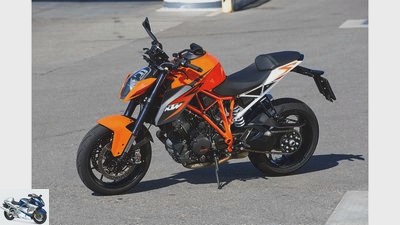
9/41
KTM 1290 Super Duke R..
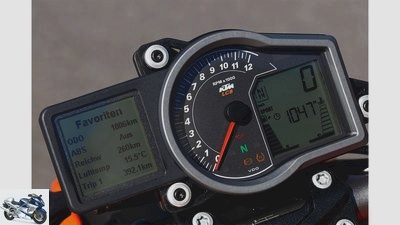
10/41
Cockpit 2.0. The favorites can be individually compiled in the display.
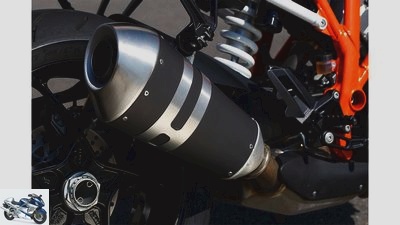
11/41
Not exactly nice, but effective: The sound of the KTM 1290 Super Duke R is generally acceptable.

12/41
Positive: The oil level is easy to check through the sight glass. Negative: The oil is difficult to refill through the angled filler neck.
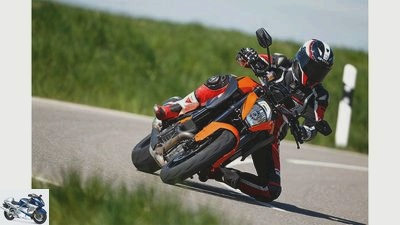
13/41
KTM 1290 Super Duke R..

14/41
KTM 1290 Super Duke R..

15/41
KTM 1290 Super Duke R..
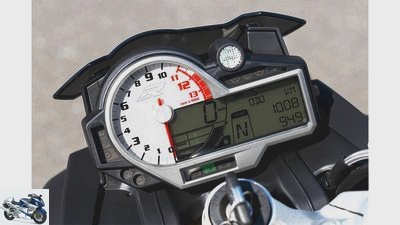
16/41
All information is perfectly prepared: clever infotainment of the BMW S 1000 R..
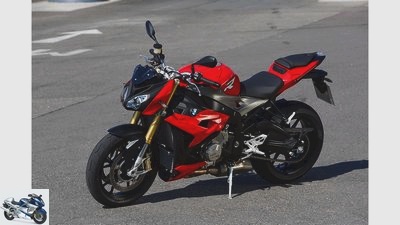
17/41
BMW S 1000 R..
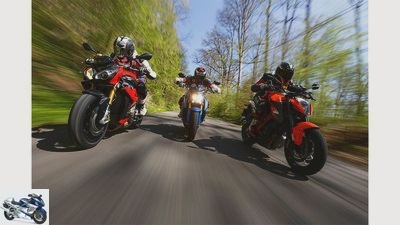
18/41
The new Suzuki GSX-S 1000 measures itself against the European competition from BMW and KTM.
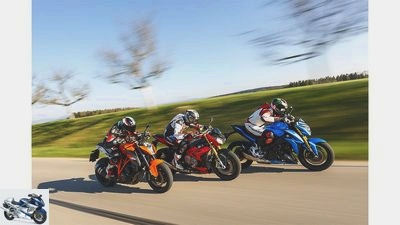
19/41
Can the Suzuki GSX-S 1000 stand up to the German-speaking bikes or possibly even outpace them?
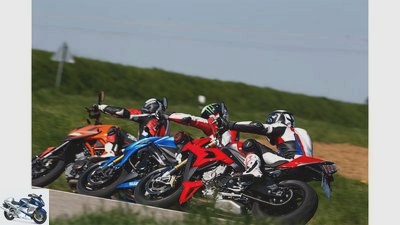
20/41
At least visually, the three bikes together make a very aesthetic impression.
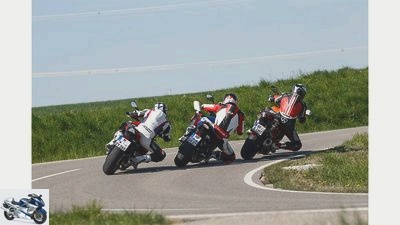
21/41
With the Bavarian and the Austrian, the Japanese naturally chose tough opponents.

22/41
BMW S 1000 R..
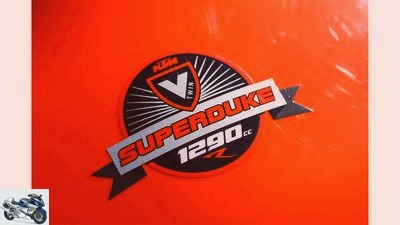
23/41
KTM 1290 Super Duke R..
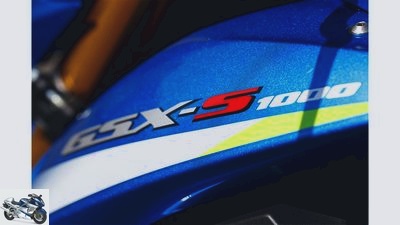
24/41
Suzuki GSX-S 1000.
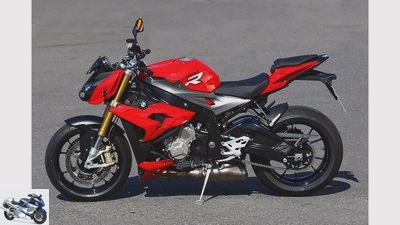
25/41
BMW’s four-cylinder in-line engine delivers 118 kW (161 hp) at 11,000 rpm.

26/41
The huge 75-degree V2 of the KTM 1290 Super Duke R impresses with 127 kW (173 hp) at 8870 rpm.
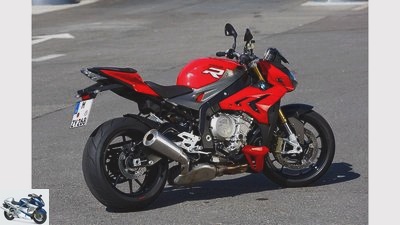
27/41
BMW S 1000 R..
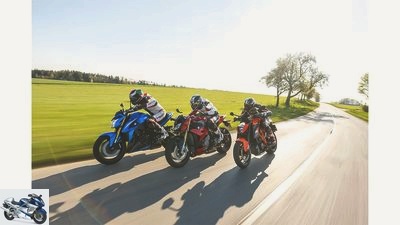
28/41
In the acceleration (0-100 km / h) the following picture emerges:
BMW S 1000 R: 3.3 s
KTM 1290 Super Duke R: 3.3 s
Suzuki GSX-S 1000: 3.0 s
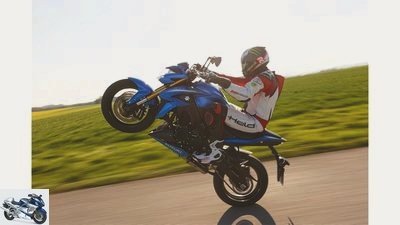
29/41
The Suzuki GSX-S 1000 comes with its 999 cm³ only 106 Nm at 9500 rpm.
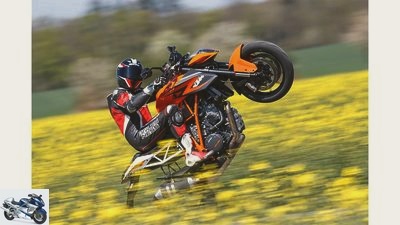
30/41
The KTM 1290 Super Duke R manages more at less speed: 144 Nm at 6500 rpm. However, also from a significantly larger displacement: 1301 cm³.
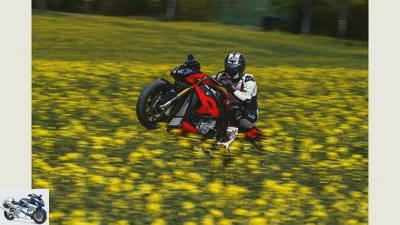
31/41
The Bavarian’s 999 cc create 112 Nm of torque at 9250 rpm.
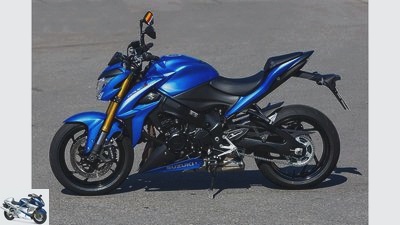
32/41
Like the BMW S 1000 R, the Suzuki GSX-S 1000 uses a four-cylinder in-line engine. An old acquaintance from the superbike engine from the K5 to K8 era.

33/41
Suzuki GSX-S 1000.
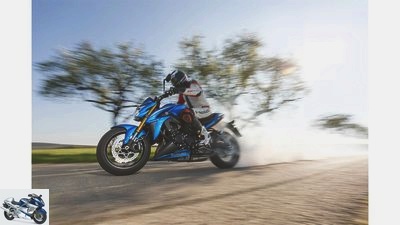
34/41
Suzuki GSX-S 1000.
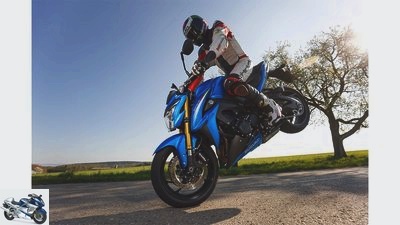
35/41
Suzuki GSX-S 1000.

36/41
The on-board computer and traction control are controlled using the gray “Mode” button.
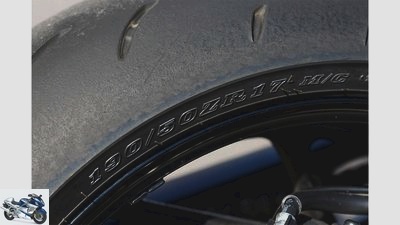
37/41
The new Suzuki is the only one that still rolls on tires with a 50 mm cross section. Probably a 55 would work even better.

38/41
Economical cockpit – and still all information at a glance.
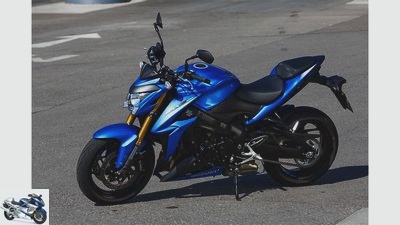
39/41
Suzuki GSX-S 1000.

40/41
Suzuki GSX-S 1000.
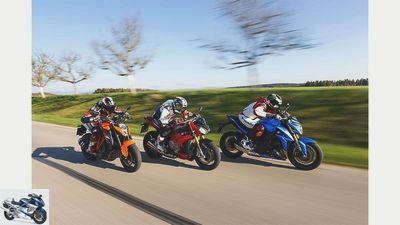
41/41
In the end, it shouldn’t be enough for the Japanese. This is mainly due to the extremely high level of European women. Especially in view of the significantly lower price, the Suzuki GSX-S 1000 is still a great bike and will find its own fan base.
KTM 1290 Super Duke R, Suzuki GSX-S 1000 and BMW S 1000 R.
Power naked bikes in a comparison test
Content of
Undisguised, performance in abundance and macho design. With such attributes, the Suzuki GSX-S 1000 attacks in the power-naked sector. The air is getting thin for the KTM 1290 Super Duke R and the BMW S 1000 R.?
For the current occasion, the impact of the new Suzuki GSX-S 1000, we have the best naked bikes, the KTM 1290 Super Duke R and the BMW S 1000 R, called for an elementary competition. When our boss reveals the test field, the tester’s eyes immediately light up. A fight for the top tester’s hat breaks out.
Buy complete article
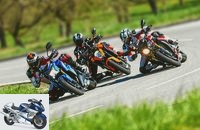
KTM 1290 Super Duke R, Suzuki GSX-S 1000 and BMW S 1000 R.
Power naked bikes in a comparison test
KTM 1290 Super Duke R, Suzuki GSX-S 1000 and BMW S 1000 R. Rob curves, savor fast and slow corners, celebrate acceleration arias in the background of the group. You can actually hear the sound of our bikes as to how which one wants to be ridden – but more on that in a moment. The troops raid closely to ensure a level playing field for the test. Bliss quickly sets in. That is exactly what makes such bikes so special. Built to enchant you, to make you forget everyday life and to merge with the winding road in front of our front doors at the highest technical level, far away from any racetrack.
The challenger is called Suzuki GSX-S 1000
Okay, all three bikes have more power than would ever be necessary for the country road. The Suzuki GSX-S 1000 even measured 12 HP more than the papers certify. 157 little horses pound to a gallop, left over by the long-stroke superbike engine from the K5 to K8 era. Suzuki did without too much electronics. Ride-by-wire, for example, is still a dream for the future. The hard throttle response of the Suzi has nothing to do with it, because there are examples for both the one and the other system that it sometimes works well or rather badly.
In the case of the Suzuki GSX-S 1000, the quadruplet should tear softer in any case. With modified camshafts – in principle the K5 engine got the camshafts of the K8 – the engineers achieved a significantly better cylinder filling and a smoother engine run than the original engine.
The blue Japanese competes against the German-speaking competition.
As a result, they not only undercut the stricter emissions standard of 2007, but also increased the speed limit – compared to the GSX-R K8, but not to the K5. And unfortunately, except for the last two courses, not in comparison to the two European combatants in this test. And there is something else that Suzuki should tackle: After the 4500 rpm mark, the Suzuki GSX-S 1000 falls into too large a performance hole that you can clearly feel when driving and that goes up to around 6500 rpm. But this is the most compatible speed range, especially on country roads.
If you as a driver shoot yourself at this peculiarity and consider yourself to be a super sportsman-like nature, you can deal with it. The GSX-S motto must therefore be: turn, turn, turn – and that is what the Suzuki GSX-S 1000 likes! It is best for the pilot to keep the engine speed beyond 7000 rpm. Then – hissing distinctly from the airbox – the otherwise rather quiet Suzuki impressively accompanies the greedy forward thrust. Grabbed by the horns, it drowns out the normally always screeching BMW – in the style of the “old” GSX-R. Their fans will love that.

Naked bike
Suzuki GSX-S 1000 in the driving report
Pure Sport Roadster?
read more
All tests and articles about the Suzuki GSX-S 1000
No unpleasant vibrations on the KTM 1290 Super Duke R.
With the two powerful cylinders and 1301 cm³ displacement it has the supposedly rougher engine by design. The KTM engineers brought up the mighty Big Twin so skillfully that anyone who drives the KTM 1290 Super Duke R once falls for the powerful engine – no trace of load changes. You have to let the key data of this propellant melt on your tongue again. At 4000 rpm the KTM already pushes a massive 117 Nm. At this speed, that’s over 20 Nm more than with the Suzuki GSX-S 1000 and the BMW S 1000 R. In addition, this is the highest mark that the equally strong Bavarian delivers at 9200 rpm. The Suzuki also offers a manageable 111 Nm at 9400 rpm as a maximum against the KTM.
The twin’s torque culminates in a top value of 142 Nm at 8100 rpm and is carried on seamlessly by the horsepower that pushes the Super Duke smoothly into the limiter at 9900 rpm. It seems as if this pithy feed is trying to pull the wrinkles out of your face. And even then, the KTM 1290 Super Duke R is alien to unpleasant vibrations.
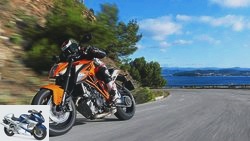
Naked bike
KTM 1290 Super Duke R in the top test
Even the neighbors get curious
read more
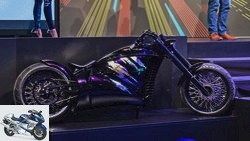
Electric
E-Choppers E-Bullet (2018)
With an electric heart and record ambitions
read more
Huge V-twin, but better manners than the Suzuki powerplant.
The same applies to the BMW S 1000 R. Its character is unmistakably a result of an in-line four-cylinder racing engine. Load change-free, the gas can be applied gently. The only disappointing thing is the low torque at low speed. The short translation cannot hide this. Compared to the KTM 1290 Super Duke R, the start is simply missing (as can be clearly seen in the performance diagram).
This means that the driver has to use the lower gear in slower passages in order to play along with the KTM 1290 Super Duke R. This is especially annoying if you don’t like it screeching loud. If, on the other hand, you don’t pay attention to the background noise and let go of the gas, the BMW S 1000 R is as if unleashed. All 168 hp can be called up in a super sporty manner as desired and converted into effective propulsion using an automatic gearshift, which is available as an additional accessory.
ABS in the BMW S 1000 R regulates late in dynamic mode
The fully equipped version with all four driving modes made available to us by BMW leaves nothing to be desired. A complex system, but one that is easy to change and adjust. Everything from the chassis to the engine to traction control and ABS is regulated at the push of a button. This electronic madness will reveal itself especially in a naked bike but only to those who deal with it in detail. However, once you understand the functions, it is exciting and quite effective to play with. We prefer the “Dynamic” mode. Here, the ABS of the BMW S 1000 R regulates late, the traction control only intervenes after harder acceleration and light wheelies are discreetly permitted even in an inclined position.
We have set the semi-active DDC chassis to “soft” in this mode in order to do justice to the not too level, mostly even bumpy country roads. When asked about the “load”, we decided on a single helmet symbol in the cockpit of the BMW S 1000 R. Adjusted in this way, the aggressive Brembo stoppers anchor much more effectively at the front, because the fork does not harden immediately and uses more travel when immersing. The ABS does not immediately shoot into the control range.
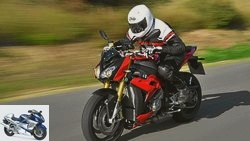
Naked bike
BMW S 1000 R in the driving report
"Maybe we calculated the price a bit cheap"
read more
Simple equipment also has its advantages
Now at the latest it becomes clear what a technical level the naked bikes already offer. The BMW S 1000 R is immense here. And yet not beyond all doubt. In our tough tests it is like in your reality on the streets: the conditions often change suddenly. While a hard setup and directional stability were the best in a long, fast corner, a nasty edge lurks in the next corner. Zack! The strut is already trampling. A little more flex in the frame might be helpful. You can set a lot with the electronics, but unfortunately it is not possible to mix while driving.
This shows once again that simplicity in the form of the Suzuki GSX-S 1000 can sometimes be more. The chassis seems to be showing its age and not very innovative. The shock absorber can only be adjusted in spring preload and rebound – there is no adjustable compression stage. And initially the Suzuki pushed outwards in corners – classic understeer.
BMW’s racing engine also reacts without load changes.
After we took a closer look at the shock absorber, the Suzuki GSX-S 1000 drove as if it had been transformed. The trick: set the spring preload to the second highest level and raise the rear with it. Even at this level there is still enough negative spring travel. Now Suzi rushes around corners much more willing. Then we turned up the rebound only half a turn (see data for complete setup). At last, targeted attacks on the KTM 1290 Super Duke R and the BMW S 1000 R. The Suzuki cannot dampen all the hard edges, but the simple trick brings calm to the line. Dunlop developed the Sportmax D214 with the special identifier M especially for the GSX-S 1000. On the one hand, the tire is characterized by high grip reserves in slippery corners. On the other hand, thanks to the neutral braking behavior, which makes even hard braking in high lean angles surprisingly relaxed.
Simplicity with Suzuki traction control too. With the throttle valve closed, buttons on the handlebar can be used to choose between three options, even while driving. All three reliably iron away wheelies – for fans of unicycle insoles, of course, this is an extremely conservative view of a power naked. But if you bring the Suzuki GSX-S 1000 to level one in full wear mode of both tires, you are already driving very ambitiously sporty. Level two regulates noticeably earlier, but allows a routinely aggressive driving style to go through. “Three” then means a net and a false bottom, nothing can actually go wrong. So if you want to wheel and burn, simply switch off the electronics. In general, the Suzuki operates very inconspicuously in the first two control levels on normal roads and thus fights on the same level as the BMW S 1000 R and the KTM 1290 Super Duke R – even if the competitors put in a much higher technical effort. We did not want to provoke an emergency along a highsider on the country road – certainly understandable.
Unfortunately the Suzuki GSX-S 1000 lacks an anti-hopping clutch
The not too sporty brakes of the Suzuki GSX-S 1000 actually fit the overall concept of the bike. The Brembo pliers don’t bite as hard as those of the BMW S 1000 R and the KTM 1290 Super Duke R, but they still convey security. The new Bosch ABS regulates late and without any tendency to roll over. Unfortunately, the anti-lock device cannot be switched off. The gearbox of the Suzuki works inconspicuously. It can be switched precisely and easily. The translation is short – similar to that of the BMW. Unfortunately the Suzuki lacks an anti-hopping clutch.
BMW and KTM, on the other hand, granted their power bikes this useful and fun feature. This means that the rear wheel does not stamp even if a gear that is too low was selected in the heat of the moment when shifting down. On top of that, thanks to the anti-hopping function, nice lines can be drawn while drifting. On the other hand, turning off the ABS or the anti-slip regulation is annoying about the Austrian. If you want to really play with the KTM 1290 Super Duke R, you have to at least deactivate the latter and also set the ABS to “Supermoto”. To do this, the engine must be running and both wheels must be stationary. Unfortunately, this setting cannot be saved either. The BMW men have solved that better, because switching and switching off is easier. The BMW “Dynamic pro” mode is unbeatable and for the experienced. Because here only the rear wheel ABS is deactivated and drifts and wheelies are possible.

Naked bike
Nine power naked bikes in a comparison test
New, renovated and tried and tested
read more
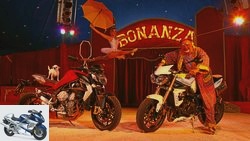
Naked bike
Comparison test: 675-series naked bikes
MV Agusta Brutale 675 and Triumph Street Triple in comparison
read more
GSX-S can convince in its own way
The driving precision of the BMW S 1000 R and the KTM 1290 Super Duke R are at almost the same, extremely high level. Both follow the lines chosen by the rider without hesitation. Whether in “hanging-off” or the classic way of pushing into the curve – that is a lot of fun. When it comes to the type of chassis adjustment, however, there are completely different approaches. If you set everything on the BMW handlebars at the push of a button, you have to use a lot of tools on the KTM. On the other hand, we find that the overall impression of the WP chassis is a tiny bit better in response than the Bavarian’s electronic counterpart.
Only hard acceleration makes the rear of the KTM 1290 Super Duke R stir a little. If you suddenly open the shower in a fully inclined position, the traction control intervenes reliably. The 142 Nm torque requested by means of ride-by-wire is passed on to the tires and the road in a regulated manner. The tremendous movement occurs between the bench and the swing arm.
All three bikes are doing really well
The Suzuki GSX-S 1000 is a lot of fun, but it suffers here and there from the weaknesses of a completely new bike that is still allowed to mature. More power in the middle would be desirable, coupled with a smoother throttle response. And Suzi would be even better at music.
The top performance fits perfectly for the purpose. In addition more aggressive stoppers, she would collect quite a lot more points. Their strength lies in their frugality. The GSX-S burns on average significantly less fuel per 100 kilometers than its competitors – despite higher speeds! And their simplicity also speaks for them, for example with the chassis. It works and at the same time depresses the price. The Suzuki GSX-S 1000 is up to 3600 euros cheaper than the KTM 1290 Super Duke R and the tested BMW S 1000 R..
Technical specifications
BMW S 1000 R, Suzuki GSX-S 1000 and KTM 1290 Super Duke R.
Readings
The performance diagram of the three opponents (performance on the crankshaft, measurements on Dynojet roller dynamometer 250).
Even for those who have not yet ridden the KTM 1290 Super Duke R, this performance diagram will make it clear: Many will still grapple with the powerful V2 of the KTM! Torque and power in abundance across the entire speed range.
Nice to see: the Suzuki GSX-S 1000 starts quite well, but then crashes into a hole and only gets serious again at high speeds. The performance above even stands out in the note. More powerful than the four-cylinder of the Suzi makes it the BMW quadruple, which starts a bit more cautiously, but lets the pig fly from 4000 rpm. The BMW S 1000 R makes no mistakes, and the engine is pure revving.
rating
The Japanese had to compete with the competitors from BMW and KTM.
rating
BMW S 1000 R.
KTM 1290 Super Duke R.
Suzuki GSX-S 1000
acceleration
9
8th
8th
Draft
9
6th
8th
Power delivery
9
10
7th
Responsiveness
8th
9
8th
Load change reaction
9
9
6th
Running culture
7th
9
6th
Gear actuation
7th
6th
9
Gear ratio
9
6th
9
Clutch function
7th
9
6th
Traction control
9
7th
8th
Subtotal
83
79
75
Driving stability
8th
8th
8th
Handiness
8th
8th
7th
Cornering stability
8th
8th
7th
feedback
8th
8th
7th
Suspension tuning in front
8th
8th
8th
Chassis set-up at the rear
7th
7th
7th
Braking effect
10
10
8th
Brake metering
9
10
8th
Righting moment when braking
9
9
8th
ABS function
9
9
9
Subtotal
84
85
77
Sitting position
8th
9
8th
Windbreak
2
3
2
Furnishing
9
8th
7th
consumption
5
6th
7th
Driving fun
9
10
8th
Subtotal
33
36
32
Total
200
200
184
placement
1.
1.
3.
Conclusion
At least visually, the three bikes together make a very aesthetic impression.
1. KTM 1290 Super Duke R
The KTM 1290 Super Duke R takes first place with the fully equipped and therefore almost equally priced BMW S 1000 R. You just have to experience this V2. Briefly pull the gas out of the speed cruising mode and the beast wakes up. With a shorter gear ratio, it would grab the crown by itself, as it gives away three points in pulling (measured in 6th gear).
1. BMW S 1000 R
The screamer! Always looking for a riot, the BMW S 1000 R is looking for opponents. Rolling quietly is hardly their strength. Big plus: The functionality and adjustability of the electronics are unparalleled and skilfully slow down too brisk driving.
3. Suzuki GSX-S 1000
The fact that the Suzuki cannot displace the previous top dogs is mainly due to the incredibly high level of the European women. Fans will still find the Suzuki GSX-S 1000, because for a relatively low price, sporty country road sweeps are cleanly served.
Related articles
-
KTM 1290 Super Duke GT, BMW S 1000 XR, Kawasaki Z 1000 SX Tourer and Suzuki GSX-S 1000 F
Arturo Rivas 32 photos Arturo Rivas 1/32 It’s like flying: a view of the Valsugana valley from the paraglider launch site in Vetriolo Terme. Arturo Rivas…
-
KTM 1290 Super Duke R in the top test
Jahn 29 photos Jahn 1/29 Jahn 2/29 Impressive: the increase in torque at 6000 rpm. Jahn 3/29 Jahn 4/29 Mitterbauer 5/29 Edged game: The Super Duke relied…
-
BMW S 1000 R against KTM 1290 Super Duke R in the test
fact 31 photos fact 1/31 With the BMW S 1000 R and the KTM 1290 Super Duke R, two of the hottest, most potent naked bikes meet here. fact 2/31 KTM went…
-
Preliminary test of the KTM 1290 Super Duke GT
KTM 11 pictures KTM 1/11 KTM 1290 Super Duke GT. KTM 2/11 KTM 1290 Super Duke GT. KTM 3/11 KTM 1290 Super Duke GT. KTM 4/11 The big twin from the super …
-
35 photos 1/35 BMW S 1000 R, Ducati Monster 1200 S, KTM 1290 Super Duke R and Triumph Speed Triple R in comparison test….
-
Suzuki GSX-S 1000 in the top test
Artist 35 photos Artist 1/35 Despite the jagged radiator cowling, round shapes dominate the GSX-S. The swing arm comes unchanged from the GSX-R super…
-
Comparison test of the 1000 super sports car
Jaime de Diego 38 photos fact 1/38 Yamaha charges 14,895 euros for their completely new R1 super sports bike. fact 2/38 Even without ABS, the Fireblade…
-
Comparison test Aprilia Tuono V4 1100 Factory, BMW S 1000 R, KTM 1290 Super Duke R, Yamaha MT-10 SP
factstudio.de 38 photos fact 1/38 Aprilia Tuono V4 1100 Factory, BMW S 1000 R, KTM 1290 Super Duke R and Yamaha MT-10 SP in comparison. fact 2/38 Aprilia…
-
BMW S 1000 RR, Ducati Multistrada, Kawasaki Z 1000 SX, KTM 1290 Super Duke R.
23 photos Artist, Jorg 1/23 Moderately readable tachometer, sober and clear displays. Artist, Jorg 2/23 The eccentric for adjusting the…
-
BMW S 1000 XR, Kawasaki ZZR 1400 and KTM 1290 Super Duke GT in the test
Andreas Riedmann 25th photos andreasriedmann.at 1/25 Picture gallery comparison test, power-speed touring bikes: BMW S 1000 XR, Kawasaki ZZR 1400, KTM…